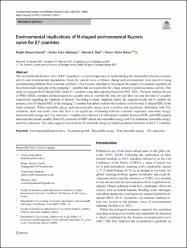Environmental implications of N-shaped environmental Kuznets curve for E7 countries
Özet
The environmental Kuznets curve (EKC) hypothesis is of great importance to understanding the relationship between economic
activity and environmental degradation. Given the current wave of climate change and environmental crisis traced to rising
environmental pollution from economic activities, it has become important to investigate the impact of economic expansion on
the environment especially in the emerging-7 countries that are responsible for a large amount of global economic activity. This
study investigates the N-shaped EKC for the E-7 countries using data spanning the period 1995–2018. The study employs the use
of PMG-ARDL estimator and heterogeneous causality tests to establish the long run and short run and direction of causality
respectively regarding the variables of interest. According to study empirical results, the long-run results fail to confirm the
presence of an N-shaped EKC in the emerging 7 countries but rather confirms the existence of an inverted U-shaped EKC in the
study countries. While renewable energy and non-renewable energy have a positive and significant relationship with CO2
emissions, short run results show that there is no significant relationship between economic expansion, renewable energy,
non-renewable energy and CO2 emissions. Causality tests showed a bi-directional causality between GDP- and GDP-squared
and a uni-directional causality from CO2 emissions to GDP-cubed, non-renewable energy and CO2 emissions, renewable energy,
and CO2 emissions. The study suggests increased use of renewable energy to mitigate pollutant emissions in the E-7 countries.
Cilt
28Sayı
25Bağlantı
https://hdl.handle.net/11363/4949Koleksiyonlar
Aşağıdaki lisans dosyası bu öğe ile ilişkilidir:


















